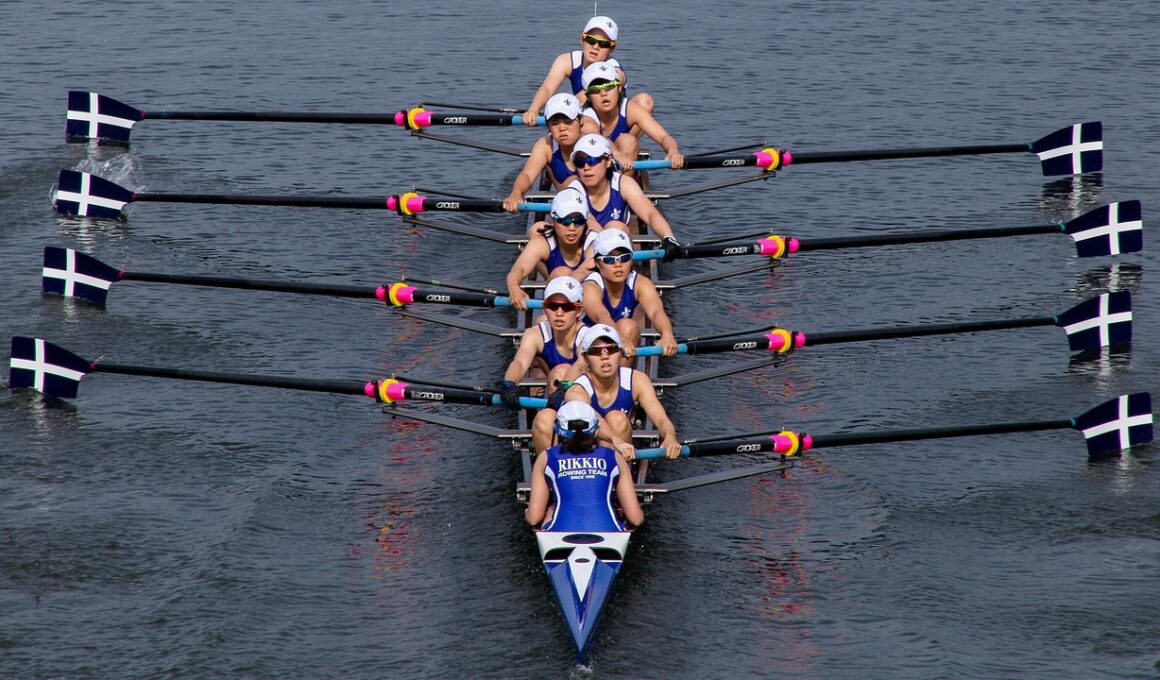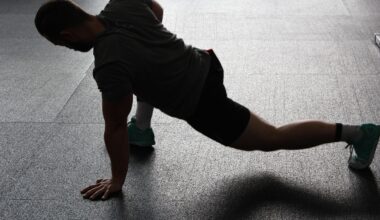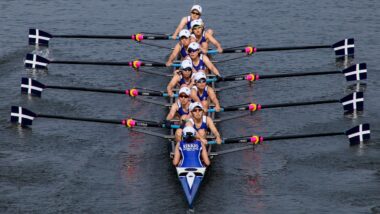Key Terms for Competitive Rowing Strategy
Understanding rowing terminology is vital for mastering the sport. Key terms, such as “stroke” and “catch,” form the foundation of competitive rowing. The “stroke” refers to the complete cycle of moving the oar through the water, which is essential for maintaining speed and efficiency. The “catch” happens at the beginning of the stroke when the oar enters the water. Consistent practice of these terms can enhance your performance. Other important terms include “sculling” and “sweep rowing.” In sculling, rowers use two oars, while in sweep rowing, each rower uses one oar. Masters of these methods demonstrate proficiency and adaptability on the water. Moreover, understanding “boat classes” is crucial; these include singles, doubles, pairs, fours, and eights, varying by the number of rowers. Additionally, knowing the role of the “coxswain” is paramount. The coxswain steers the boat and manages race strategy. Keeping these terms in mind ensures effective communication and strategy within the crew, optimizing performance during competitions. A thorough grasp of the terminology elevates both individual and team success in the sport of rowing.
The Importance of Rowing Terminology
Terms like “rate” and “tempo” play crucial roles in competitive rowing. The “rate” refers to the number of strokes per minute, while the “tempo” signifies the pace at which rowing occurs. Maintaining a balanced rate is essential for achieving peak performance. Furthermore, the term “ergometer” refers to equipment used for indoor rowing training, allowing rowers to simulate water conditions. It builds strength, endurance, and technique in a controlled environment. As rowers progress, they may encounter terms such as “drafting,” a technique involving positioning behind another rower to reduce wind resistance. Understanding this technique can enhance overall speed during races. The term “power stroke” denotes the most forceful part of the stroke, emphasizing the need for rowers to maximize their output in this phase. Additionally, the concept of “finishing strong” highlights the importance of maintaining strength through the end of the stroke cycle. Each of these terms enhances a crew’s competitive edge. By focusing on the terminology, teams improve coordination and execution during races, which can be the difference between victory and defeat.
Another vital term is “blade,” which refers to the part of the oar that enters the water. The size and design of the blade affect performance. Understanding the mechanics of the blade can lead to better rowing efficiency and smoother movements on the water. Likewise, the term “layback” describes the angle of the rower’s body at the finish of a stroke, which directly influences the energy transfer into the water. Proper layback mechanics can result in more powerful strokes and enhanced speed. Additionally, the term “back rowing” describes a rowing maneuver that allows the crew to move in reverse, essential for navigation in tight spaces. Knowledge of such terms ensures that all crew members are on the same page. Furthermore, “keep the water clean” is a phrase often used in rowing to signify minimal splashing during strokes, illustrating the importance of maintaining efficiency in rowing mechanics. This focus on smooth movements enhances speed and reduces fatigue. Awareness of these terms contributes to rowing proficiency, fostering teamwork and ensuring the entire crew performs cohesively in races.
Technical Aspects of Rowing Terminology
Terms related to boat handling are just as significant as those for rowing techniques. “Swing” refers to the rhythmic movement of the crew, which creates balance and reduces drag. The goal is for each rower to move in harmony, ensuring the boat glides smoothly through the water. Additionally, “trimming” the boat involves adjusting the weight distribution to maintain stability. A trimmed boat moves more efficiently. The term “coxbox” is essential; it’s a device used by the coxswain for communication and managing race strategy. Effective use of a coxbox enables the coxswain to provide real-time feedback, vital during competitive races. Another term, “overreaching,” describes the motion where a rower extends their arms too far during the stroke, which can lead to fatigue or injury. Understanding these technical terms can significantly impact training and race outcomes. Furthermore, the term “gaining water” is used to describe the moment when a crew takes the lead over its competitors. Awareness of such terms fosters a deeper understanding of race dynamics and triumphant strategies. Consequently, knowledge of rowing terminology promotes overall success in the competitive rowing scene.
The role of the “stroke seat” is intrinsic in rowing; this is the rower who sets the pace and rhythm for the crew. Their effectiveness hinges on a detailed understanding of technique, strength, and rhythm. Conversely, the “bow seat” is the frontmost rower, which plays an indispensable role in steering and stability. The unique responsibilities of each seat underscore their significance in achieving synchronized performance. Moreover, the concept of “balance” is paramount; maintaining equilibrium within the boat ensures that each stroke is efficient, reducing energy waste. The term “power-to-weight ratio” quantifies the relationship between a rower’s weight and the power they can exert, a critical calculation affecting speed and overall performance. Lastly, the phrase “moving through the water” describes how effectively the boat glides during rowing. This concept can dramatically affect race times. All these terms are not merely jargon; they reflect the ingenuity and skill required in rowing. As rowers become familiar with these terms, they contribute to a more cohesive and successful crew, fostering teamwork and understanding in the spirit of competition.
Rowing Strategy and Terminology
Rowing strategy is largely informed by crucial terminology, such as “split time.” This metric indicates the time taken to cover a given distance, essential for pacing. Monitoring split times allows crews to gauge performance during races, indicating when to exert more power or conserve energy. The term “push” describes the concentrated effort a crew exerts to accelerate the boat, often applied in strategic bursts during critical race moments. The phrase “race plan” encapsulates the pre-established tactics that teams implement during competition, vital for coordinating movements and optimizing performance. Additionally, the term “breakaway” denotes the moment a crew pulls ahead of their competition, requiring strategic execution and meaningful communication. Rowers discuss their individual growth through “seat racing,” where they compete against fellow teammates for optimal placements in the boat. Learning these terms enables boat crews to discuss strategies effectively and adapt to the unfolding race dynamics. Moreover, “calling a race” refers to the act of a coxswain directing their crew during a race, highlighting the importance of leadership within rowing dynamics. Mastery of these strategic terms becomes essential for achieving a competitive edge in high-stakes racing.
The term “power application” refers to how forcefully a rower can push on the oar during the stroke, which has direct implications for boat speed. Understanding how to apply power effectively is critical for both speed and efficiency. Additionally, “wind and water conditions” must also be assessed before any race. Factors such as flow, current, and wind can significantly influence racing strategies. Terms like “headwind” and “tailwind” describe the challenges posed by environmental elements, informing how crews adjust their tactics. Moreover, “settle” is a term that refers to the period after a burst of speed when a crew stabilizes its pace, vital for maintaining endurance. This phase requires a strong focus and excellent team communication. Another significant term is “finishing, which describes how effectively a boat completes a stroke as it approaches the end of the race. Improving stroke finish leads to enhanced speed and overall race performance. Lastly, understanding the importance of “mental strategies” reveals how mindset influences performance. These strategies help rowers stay calm and maintain focus. The depth of knowledge regarding rowing terminology equips athletes to face competitions confidently.
Conclusion on Rowing Terminology
Mastering the terminology of rowing is instrumental for aspiring and competitive rowers alike. Recognizing key terms fosters effective communication within the crew, allowing for synchronized movements that enhance overall performance. Through the practice of the aforementioned terms, rowers can gain invaluable insights into their strategies and techniques, creating a comprehensive approach to training and competition. Moreover, embracing the rich vocabulary of rowing can help bridge knowledge gaps between various experience levels within teams. As new rowers assimilate these terms, they become more integrated into their crews, promoting camaraderie and understanding. Additionally, integrating rowing vocabulary into practice helps reinforce the principles of teamwork and strategic development. This understanding elevates confidence, enabling rowers to execute their roles more proficiently during both training and competitive races. Through consistent application of these terms, rowers can cultivate their individual skills while contributing to the collective success of their teams. The dedication to learning and applying rowing terminology exemplifies commitment to excellence in the sport. Enhanced communication, trust, and strategy flourish alongside a mastery of rowing terms, ultimately leading to improved performance on the racecourse.





